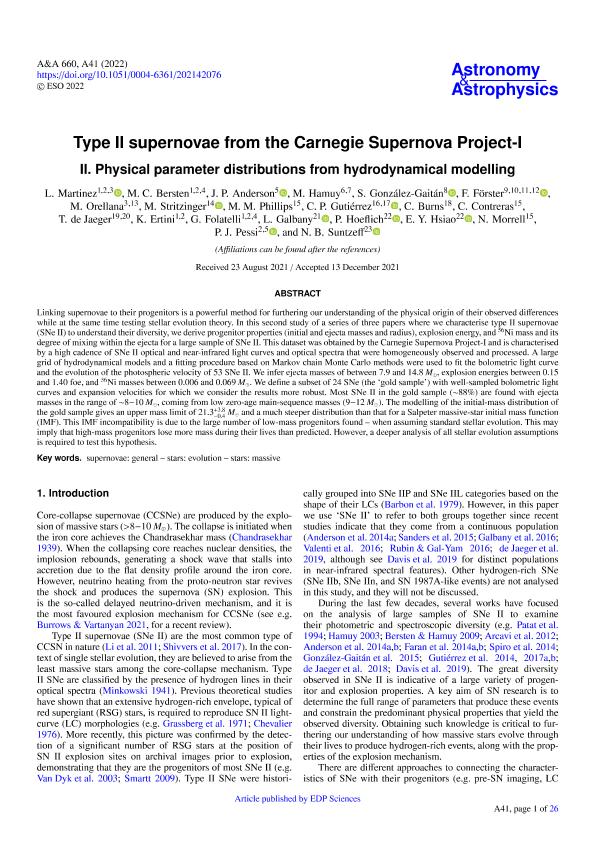Mostrar el registro sencillo del ítem
dc.contributor.author
Martinez, Laureano

dc.contributor.author
Bersten, Melina Cecilia

dc.contributor.author
Anderson, J. P.
dc.contributor.author
Hamuy, Mario

dc.contributor.author
González Gaitán, S.
dc.contributor.author
Förster, F.
dc.contributor.author
Orellana, Mariana Dominga

dc.contributor.author
Stritzinger, Maximilian

dc.contributor.author
Phillips, M. M.
dc.contributor.author
Gutiérrez, C. P.
dc.contributor.author
Burns, C.
dc.contributor.author
Contreras, C.
dc.contributor.author
de Jaeger, T.
dc.contributor.author
Ertini, Keila Yael

dc.contributor.author
Folatelli, Gaston

dc.contributor.author
Galbany, Lluís

dc.contributor.author
Hoeflich, Peter

dc.contributor.author
Hsiao, Eric

dc.contributor.author
Morrell, Nidia Irene

dc.contributor.author
Pessi, Priscila Jael

dc.contributor.author
Suntzeff, Nicholas B.

dc.date.available
2023-09-19T00:28:44Z
dc.date.issued
2022-04
dc.identifier.citation
Martinez, Laureano; Bersten, Melina Cecilia; Anderson, J. P.; Hamuy, Mario; González Gaitán, S.; et al.; Type II supernovae from the Carnegie Supernova Project-I: II. Physical parameter distributions from hydrodynamical modelling; EDP Sciences; Astronomy and Astrophysics; 660; A41; 4-2022; 1-26
dc.identifier.issn
0004-6361
dc.identifier.uri
http://hdl.handle.net/11336/211912
dc.description.abstract
Linking supernovae to their progenitors is a powerful method for furthering our understanding of the physical origin of their observed differences while at the same time testing stellar evolution theory. In this second study of a series of three papers where we characterise type II supernovae (SNe II) to understand their diversity, we derive progenitor properties (initial and ejecta masses and radius), explosion energy, and 56Ni mass and its degree of mixing within the ejecta for a large sample of SNe II. This dataset was obtained by the Carnegie Supernova Project-I and is characterised by a high cadence of SNe II optical and near-infrared light curves and optical spectra that were homogeneously observed and processed. A large grid of hydrodynamical models and a fitting procedure based on Markov chain Monte Carlo methods were used to fit the bolometric light curve and the evolution of the photospheric velocity of 53 SNe II. We infer ejecta masses of between 7.9 and 14.8 M, explosion energies between 0.15 and 1.40 foe, and 56Ni masses between 0.006 and 0.069 M. We define a subset of 24 SNe (the gold sample) with well-sampled bolometric light curves and expansion velocities for which we consider the results more robust. Most SNe II in the gold sample (88%) are found with ejecta masses in the range of 810 M, coming from low zero-age main-sequence masses (912 M). The modelling of the initial-mass distribution of the gold sample gives an upper mass limit of 21.3{+3.8} {-0.4}M and a much steeper distribution than that for a Salpeter massive-star initial mass function (IMF). This IMF incompatibility is due to the large number of low-mass progenitors found when assuming standard stellar evolution. This may imply that high-mass progenitors lose more mass during their lives than predicted. However, a deeper analysis of all stellar evolution assumptions is required to test this hypothesis.
dc.format
application/pdf
dc.language.iso
eng
dc.publisher
EDP Sciences

dc.rights
info:eu-repo/semantics/openAccess
dc.rights.uri
https://creativecommons.org/licenses/by-nc-sa/2.5/ar/
dc.subject
STARS: EVOLUTION
dc.subject
STARS: MASSIVE
dc.subject
SUPERNOVAE: GENERAL
dc.subject.classification
Astronomía

dc.subject.classification
Ciencias Físicas

dc.subject.classification
CIENCIAS NATURALES Y EXACTAS

dc.title
Type II supernovae from the Carnegie Supernova Project-I: II. Physical parameter distributions from hydrodynamical modelling
dc.type
info:eu-repo/semantics/article
dc.type
info:ar-repo/semantics/artículo
dc.type
info:eu-repo/semantics/publishedVersion
dc.date.updated
2023-09-14T17:41:40Z
dc.journal.volume
660
dc.journal.number
A41
dc.journal.pagination
1-26
dc.journal.pais
Francia

dc.journal.ciudad
Paris
dc.description.fil
Fil: Martinez, Laureano. Consejo Nacional de Investigaciones Científicas y Técnicas. Centro Científico Tecnológico Conicet - La Plata. Instituto de Astrofísica La Plata. Universidad Nacional de La Plata. Facultad de Ciencias Astronómicas y Geofísicas. Instituto de Astrofísica La Plata; Argentina
dc.description.fil
Fil: Bersten, Melina Cecilia. Consejo Nacional de Investigaciones Científicas y Técnicas. Centro Científico Tecnológico Conicet - La Plata. Instituto de Astrofísica La Plata. Universidad Nacional de La Plata. Facultad de Ciencias Astronómicas y Geofísicas. Instituto de Astrofísica La Plata; Argentina
dc.description.fil
Fil: Anderson, J. P.. European Southern Observatory Chile.; Chile
dc.description.fil
Fil: Hamuy, Mario. Texas A&M University; Estados Unidos
dc.description.fil
Fil: González Gaitán, S.. Universidade de Lisboa; Portugal
dc.description.fil
Fil: Förster, F.. Universidad de Chile.; Chile
dc.description.fil
Fil: Orellana, Mariana Dominga. Consejo Nacional de Investigaciones Científicas y Técnicas; Argentina. Universidad Nacional de Río Negro; Argentina
dc.description.fil
Fil: Stritzinger, Maximilian. University Aarhus; Dinamarca
dc.description.fil
Fil: Phillips, M. M.. Carnegie Observatories; Estados Unidos
dc.description.fil
Fil: Gutiérrez, C. P.. University Of Turku; Finlandia
dc.description.fil
Fil: Burns, C.. Observatories Of The Carnegie Institution For Science; Estados Unidos
dc.description.fil
Fil: Contreras, C.. Carnegie Observatories; Estados Unidos
dc.description.fil
Fil: de Jaeger, T.. University Of Hawaii; Estados Unidos
dc.description.fil
Fil: Ertini, Keila Yael. Consejo Nacional de Investigaciones Científicas y Técnicas. Centro Científico Tecnológico Conicet - La Plata. Instituto de Astrofísica La Plata. Universidad Nacional de La Plata. Facultad de Ciencias Astronómicas y Geofísicas. Instituto de Astrofísica La Plata; Argentina
dc.description.fil
Fil: Folatelli, Gaston. Consejo Nacional de Investigaciones Científicas y Técnicas. Centro Científico Tecnológico Conicet - La Plata. Instituto de Astrofísica La Plata. Universidad Nacional de La Plata. Facultad de Ciencias Astronómicas y Geofísicas. Instituto de Astrofísica La Plata; Argentina
dc.description.fil
Fil: Galbany, Lluís. Institute Of Space Sciences; España
dc.description.fil
Fil: Hoeflich, Peter. Florida State University; Estados Unidos
dc.description.fil
Fil: Hsiao, Eric. Florida State University; Estados Unidos
dc.description.fil
Fil: Morrell, Nidia Irene. Carnegie Observatories; Estados Unidos. Consejo Nacional de Investigaciones Científicas y Técnicas. Centro Científico Tecnológico Conicet - La Plata. Instituto de Astrofísica La Plata. Universidad Nacional de La Plata. Facultad de Ciencias Astronómicas y Geofísicas. Instituto de Astrofísica La Plata; Argentina
dc.description.fil
Fil: Pessi, Priscila Jael. Consejo Nacional de Investigaciones Científicas y Técnicas. Centro Científico Tecnológico Conicet - La Plata. Instituto de Astrofísica La Plata. Universidad Nacional de La Plata. Facultad de Ciencias Astronómicas y Geofísicas. Instituto de Astrofísica La Plata; Argentina. European Southern Observatory Chile.; Chile
dc.description.fil
Fil: Suntzeff, Nicholas B.. Texas A&M University; Estados Unidos
dc.journal.title
Astronomy and Astrophysics

dc.relation.alternativeid
info:eu-repo/semantics/altIdentifier/doi/http://dx.doi.org/10.1051/0004-6361/202142076
dc.relation.alternativeid
info:eu-repo/semantics/altIdentifier/url/https://www.aanda.org/articles/aa/full_html/2022/04/aa42076-21/aa42076-21.html
Archivos asociados
